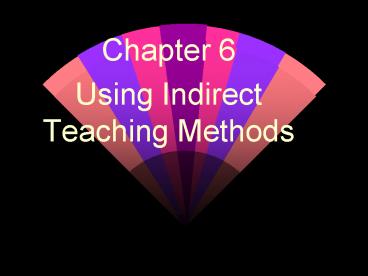Using Indirect Teaching Methods - PowerPoint PPT Presentation
1 / 17
Title:
Using Indirect Teaching Methods
Description:
Chapter 6 Using Indirect Teaching Methods * * * * The Discussion Method Classroom goals: Questions that explore controversial issues (with no simple answer) increase ... – PowerPoint PPT presentation
Number of Views:374
Avg rating:3.0/5.0
Title: Using Indirect Teaching Methods
1
- Chapter 6
- Using Indirect Teaching Methods
2
The Discussion Method
- Classroom goals
- Questions that explore controversial issues (with
no simple answer) increase knowledge and
encourage deeper understanding of the various
sides presented. - Discussions addressing issues from the affective
domain are more effective in changing attitudes,
values, and behaviors.
3
Discussion Method Roles
- A discussion leader keeps the discussion on track
by stating topic, posing questions, and
summarizing major points. - A recorder keeps notes, creates a summary, and
records the groups conclusion. - Participants are prepared. They review materials
provided, come ready to listen, and ask
questions. - Teachers must plan the discussion and execute the
plan. - identify goals and provide information prior to
discussion - plan for large-group or small-group activity
- determine seating arrangement
- plan for the time involved
4
Whole-Class or Small-Group?
- Whole-class discussions
- Teacher serves as passive moderator.
- Topic is appropriate for whole-class discussion.
- Procedures or ground rules are outlined for
students.(summary of last comment, no sarcasm, no
making fun, only topic at hand) - Set(how start) and closure (wrap-up) must be
planned. - Use listen-read-and-discuss to build discussions
around textbook.(pg 174)
5
Whole-Class or Small-Group? (cont.)
- Small-group discussions
- Should follow the presentation of information.
- Provide clear guidelines for groups and designate
a small-group leader. - Ideas and conclusions recorded by the appointed
recorder. - Conclusions reported to rest of the class.
6
Four types of small-groups
- Brainstorming
- used to generate ideas around topic or problem
presented - Buzz Group
- established quickly to share opinions,
viewpoints, or reactions - Task Group
- set up to solve a problem or complete a project
- Panel
- prepares in advance to present an informal
discussion to be followed by a whole-class
discussion
7
Heuristic Methods
- A problem solving process that is active,
somewhat self-directed, inquiring, and reflective - Heuristic approaches
- discovery
- inquiry
8
Levels of Problem Solving
9
Discovery Learning
- intentional learning through supervised problem
solving following the scientific method of
investigation. - Follows the general scientific method for
conducting an investigation - Takes place at 3 levels
- guided discovery
- modified discovery
- open discovery
10
Discovery Learning Strategies
- Selecting the problem.
- Proposing possible solutions.
- Collecting of data.
- Data analysis and interpretation.
- Testing conclusions.
11
Discovery Learning
- Benefits
- active learning
- intrinsic motivation
- increased learning and retention
- development of positive social skills
- Limitations
- little feedback
- amount of material covered is limited
- adjustment for both teacher and students
12
Inquiry Learning
- Emphasis is on the process of investigating the
problem - Does not require solutions to problems
- Pattern for reaching solution is not established
- 3-step procedure is followed
- identify the problem
- work toward solutions
- establish solutions
- (Bruner, 2004)
13
The Five-E Inquiry Model (pg.184)
- Step 1-Engage problem defined
- Step 2-Explore actively explore
- Step 3-Explain verbalize their exploration
- Step 4-Elaborate expand , make connections,
apply understandings - Step 5-Evaluate teacher determines
understanding - this model is based on the constructivist
approach to learning
14
Inquiry Learning
- Benefits
- creative solutions developed
- stimulates interest
- students not penalized for lack of knowledge
- failure not possiblegtgtenhanced confidence
- Limitations
- can appear chaotic
- anticipating and locating materials can be
challenging - demanding of time
- difficult to evaluate student progress
15
Systemic Problem Solving (International
Technology Education Association)
- Defining the problem
- Brainstorming
- Researching and generating ideas
- Identifying criteria and specifying constraints
- Exploring possibilities
- Selecting an approach
- Developing a design proposal
- Making a model or prototype
- Testing and evaluating the design using
specifications - Refining the design
- Creating or making the solution
- Communicating the processes and results
16
Teachers Role
- Facilitates
- Continuously monitors students
- Identifies and rectifies problems immediately
- Deals with management/discipline problems
- Works one-on-one with students
- Supports/scaffolds students work during
systematic investigation of problems - Systematic planning
- Practices flexibility
17
Classroom Environment
- An environment that grants freedom for exploring
problems - Necessary materials and equipment are available
to students - Cooperation, trust, self-control, conviction and
a sense of openness is essential































